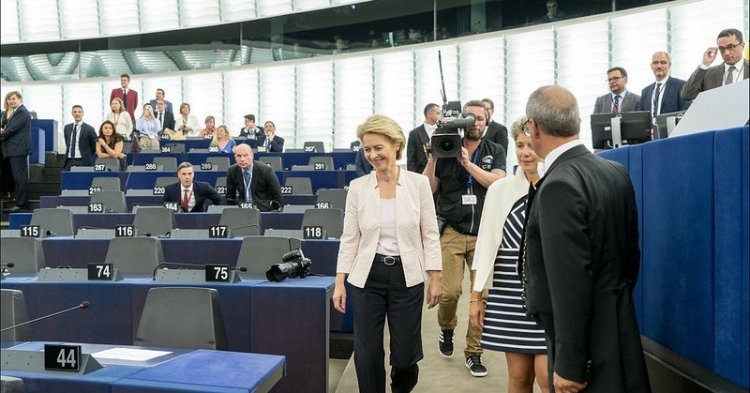Ursula von der Leyen has now been the European Commission President for almost a year. Although she has not made as many headline-worthy quips as her predecessor Jean-Claude Juncker, von der Leyen has in the past months become a household name among those who follow politics.
Yet the passing of time has not removed the “original sin” of von der Leyen’s presidency. When EU member state leaders nominated the then-defence minister for Germany as the President last summer, her name entered the discussion as a complete surprise. Manfred Weber, Frans Timmermans and other candidates who had spent months campaigning for election as Commission President were brutally discarded.
As one of her first promises after her nomination, von der Leyen vowed to revive the “Spitzenkandidaten” process which would connect the choice of the Commission President to the European election results. If successful, the promise would mean that after 2024, the Commission President would once again be a politician who headed the campaign of a European party family during the elections.
Von der Leyen expressed her hope that discussions during the “Conference on the Future of Europe” would bring clarity on the Spitzenkandidaten question. The Conference, likely comprising a series of discussion events and an online idea platform, is intended as a grand debate on the EU’s role and powers, but the launch has already been delayed for months by the COVID pandemic and by disagreements in Brussels over who should chair the conference.
What did Spitzenkandidaten mean in 2019? Nobody knows
Once the Conference kicks off, the key task for the Spitzenkandidaten discussion is to reach consensus on what the process actually means. After the 2019 elections, one problem that led to the outsider von der Leyen’s selection was that different actors advanced competing definitions for the procedure. Given the opposition that the Spitzenkandidaten idea is facing, disunity among supporters of the concept proved fatal.
During and after the election, supporters of Manfred Weber – whose centre-right EPP alliance predictably came first in the elections – argued that the process is only respected if the lead candidate of the victorious party becomes the next President. Among Weber’s opponents, you could hear that the President could be any of the lead candidates, depending on who can form a majority in the European Parliament.
There was no clear text which could conclusively explain whose interpretation is right. The EU treaties don’t have an answer, because the system is based on tacit agreement rather than the letter of the law. Precedent from 2014 could not help either: Jean-Claude Juncker was the lead candidate of the largest party, but he also secured majority support in the European Parliament immediately after the election results became clear. Therefore, the question of why Juncker was the legitimate candidate for Commission President never needed to be asked.
As a result, the true meaning of Spitzenkandidaten was left unclear even for devout observers, let alone for the general public. Consider one illustrative example. On 2 July last year, the French newspaper Le Figaro wrote an article about the race for the Commission presidency, and said that, under the Spitzenkandidaten procedure, the President would be the lead candidate who can assemble a majority in the European Parliament. Everything clear so far. The only problem is that the relevant sentence contained a link to another Figaro article, which clearly explained that the candidate of the winning party should become the President! If the rules of the game are as muddy as this, the candidates’ ability to claim a genuine popular mandate inevitably suffers.
An opportunity to set the record straight
The Conference on the Future of Europe will be an opportunity to tackle the question of definitions head on. A memorandum of understanding between the European-level parties would help to avert any post-election quarrels, as both the political groups sitting in the European Parliament and the informal partisan groupings present in the European Council would feel bound by the agreement.
There is only one question to answer, and it is a simple one: does the Spitzenkandidaten idea imply an automatic link between coming first in the European elections, and winning the Commission presidency? The problem is that while the issue may look like a sterile and theoretical one, the EPP’s domination in European elections makes the question nearly synonymous with whether the EPP’s candidate should become the President. The EPP has come first in every European election since 1994, and early projections by Europe Elects suggest that this won’t change in 2024.
Yet however unlikely it may seem now, explicitly agreeing that the victorious party’s candidate will automatically win the presidency might lead to an unpleasant scenario, should a Eurosceptic alliance snatch the victory in the future. Presumably, pro-European parties would be quick to emphasise the need for a majority in the European Parliament, and unite behind another candidate. If European-level parties have the patience to be careful what they wish for, they should logically deny an automatic link between coming first and winning the presidency – and instead, define Spitzenkandidaten through the need for a parliamentary majority.
Though this argument seems entirely logical to me, it is just one possibility for solving the puzzle. Meanwhile, the next election campaign is only three years away. As time is running out, the overriding goal should be to find the clarity that enables us EU-watchers to explain the Spitzenkandidaten process to our parents and neighbours during the next election.
Whichever way the political parties decide to conceptualise the system, as a good European citizen I shall do my best to share the idea with the people around me. But first, I need someone to tell me what the idea is.


Follow the comments: |
|
